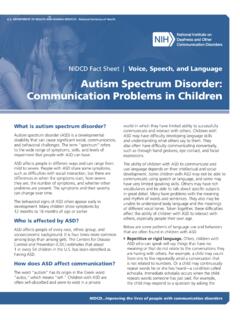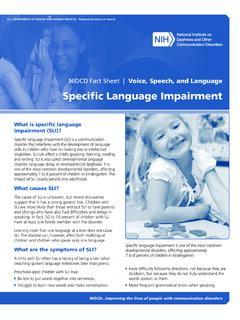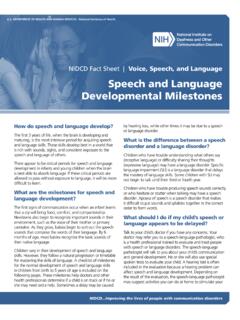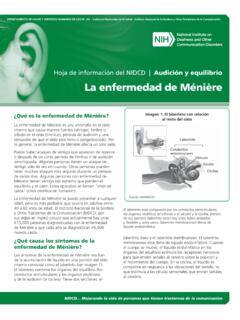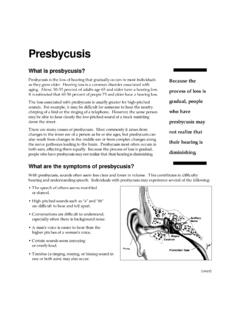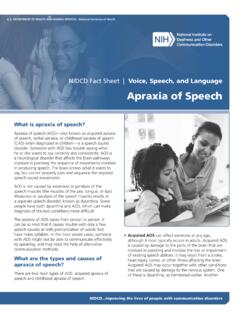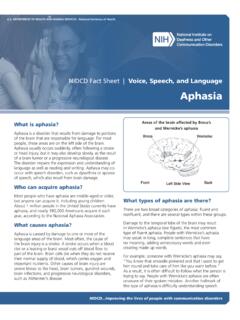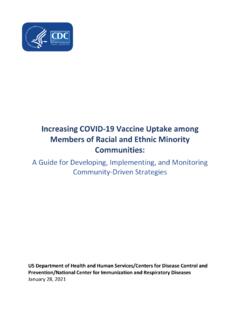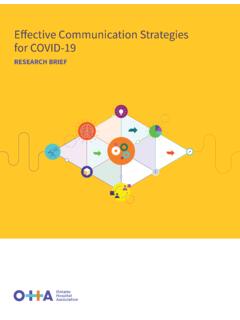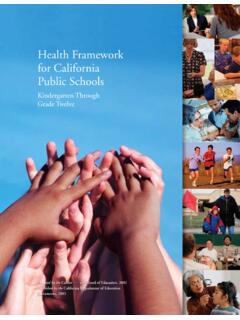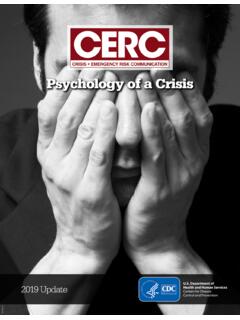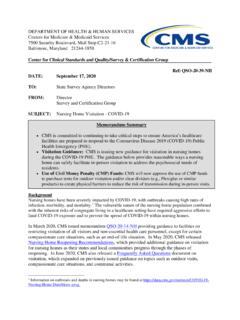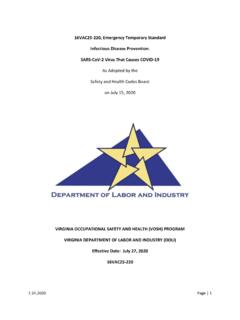Transcription of Communication Problems in Children with Autism Spectrum ...
1 The lives of people with Communication DEPARTMENT OF HEALTH AND HUMAN SERVICES National Institutes of HealthNIDCD Fact Sheet | Voice, Speech, and LanguageCommunication Problems in Children with Autism Spectrum DisorderWhat is Autism Spectrum disorder? Autism Spectrum disorder (ASD) covers a set of developmental disabilities that can cause significant social, Communication , and behavioral challenges. People with ASD process information in their brain differently than other people. ASD affects people in different ways and can range from mild to severe. People with ASD share some symptoms, such as difficulties with social interaction, but there are differences in when the symptoms start, how severe they are, how many symptoms there are, and whether other Problems are present.
2 The signs of ASD begin before the age of 3, although some Children may show hints of future Problems within the first year of life. Who is affected by ASD?ASD affects people of every race, ethnic group, and socioeconomic background, but it is five times more common among boys than among girls. The centers for disease control and prevention (CDC) estimates that about 1 out of every 88 Children will be identified with ASD. How does ASD affect Communication ?The word Autism has its origin in the Greek word autos, which means self. Children with ASD often are self-absorbed and seem to exist in a private world where they are unable to successfully communicate and interact with others.
3 Children with ASD may have difficulty developing language skills and understanding what others say to them. They also may have difficulty communicating nonverbally, such as through hand gestures, eye contact, and facial expressions. Not every child with ASD will have a language problem. A child s ability to communicate will vary, depending upon his or her intellectual and social development. Some Children with ASD may be unable to speak. Others may have rich vocabularies and be able to talk about specific subjects in great detail. Most Children with ASD have little or no problem pronouncing words.
4 The majority, however, have difficulty using language effectively, especially when they talk to other people. Many have Problems with the meaning and rhythm of words and sentences. They also may be unable to understand body language and the nuances of vocal tones. Below are some patterns of language use and behaviors that are often found in Children with ASD. }Repetitive or rigid language. Often, Children with ASD who can speak will say things that have no meaning or that seem out of context in conversations with others. For example, a child may count from one to five repeatedly.
5 Or a child may repeat words he or she has heard over and over, a condition called echolalia. Immediate echolalia occurs when the child repeats words someone has just said. For example, the child may respond to a question by asking the same question. In delayed echolalia, the child will repeat words heard at an earlier time. The child may say Do you want something to drink? whenever he or 2she asks for a drink. Some Children with ASD speak in a high-pitched or singsong voice or use robot-like speech. Other Children may use stock phrases to start a conversation.
6 For example, a child may say My name is Tom, even when he talks with friends or family. Still others may repeat what they hear on television programs or commercials. }Narrow interests and exceptional abilities. Some Children may be able to deliver an in-depth monologue about a topic that holds their interest, even though they may not be able to carry on a two-way conversation about the same topic. Others have musical talents or an advanced ability to count and do math calculations. Approximately 10 percent of Children with ASD show savant skills, or extremely high abilities in specific areas, such as calendar calculation, music, or math.
7 }Uneven language development. Many Children with ASD develop some speech and language skills, but not to a normal level of ability, and their progress is usually uneven. For example, they may develop a strong vocabulary in a particular area of interest very quickly. Many Children have good memories for information just heard or seen. Some Children may be able to read words before 5 years of age, but they may not comprehend what they have read. They often do not respond to the speech of others and may not respond to their own names. As a result, these Children sometimes are mistakenly thought to have a hearing problem.
8 }Poor nonverbal conversation skills. Children with ASD often are unable to use gestures such as pointing to an object to give meaning to their speech. They often avoid eye contact, which can make them seem rude, uninterested, or inattentive. Without meaningful gestures or the language to communicate, many Children with ASD become frustrated in their attempts to make their feelings and needs known. They may act out their frustrations through vocal outbursts or other inappropriate behaviors. How are the speech and language Problems of ASD treated? If a doctor suspects a child has ASD or another developmental disability, he or she usually will refer the child to a variety of specialists, including a speech-language pathologist.
9 This is a health professional trained to treat individuals with voice, speech, and language disorders. The speech-language pathologist will perform a comprehensive evaluation of the child s ability to communicate and design an appropriate treatment program. In addition, the pathologist might make a referral for audiological testing to make sure the child s hearing is normal. Teaching Children with ASD how to communicate is essential in helping them reach their full potential. There are many different approaches to improve Communication skills. The best treatment program begins early, during the preschool years, and is tailored to the child s age and interests.
10 It also will address both the child s behavior and Communication skills and offer regular reinforcement of positive actions. Most Children with ASD respond well to highly structured, specialized programs. Parents or primary caregivers as well as other family members should be involved in the treatment program so it will become part of the child s daily life. For some younger Children , improving verbal Communication is a realistic goal of treatment. Parents and caregivers can increase a child s chance of reaching this goal by paying attention to his or her language development early on.

